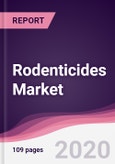What is Rodenticides?
Rodenticides are pesticides that are used to kill rodents such as rats & mice, squirrels, chipmunks, woodchucks and others causing crop damage, food contamination, transmit diseases and also cause severe economic damage. Rodents cause substantial amounts of damage and wastage of foodstuffs and also violates housing codes around the world. Every year an estimated $30 billion in food products are been destroyed by rats and mice globally. Further, they spread bacteria and leave filth in food. Therefore, rodenticides currently remain the most effective measure to reduce damage and losses to rodents. Manufacturing and registration costs, toxicity levels, potential hazards to children and government regulations are few dynamics shaping the future of rodenticides market.
This report incorporates an in-depth assessment of rodenticides market by rodents, form, application, end-user and geography. The major types of rodenticides included in the scope includes various anticoagulant such as first-generation anticoagulants, and second-generation anticoagulants.
What are the major end-user for rodenticides?
The rodenticides are used to control all types of rodents in all possible places. Rodenticides are acute poisons, anticoagulants and bio agents which are dangerous to humans, domestic animals and wildlife, if misused. Rodents are a problem only when they have access to a palatable food source. The most effective way to treat rodent problems is with a combined approach of different control methods including chemical, baiting, trapping, barrier fencing, habitat modification, ultrasonic devices, repellents and biological control, integrated with land management practices. These rodenticides are used in agricultural fields, warehouses, urban centerss and other places. The agriculture segments is one of the largest revenue generating segment for rodenticides. The focus on organic farming is shrinking the demand of rodenticides in agriculture in advanced economies which is offset by demand for pest control in the developing economies with agriculture being the crucial sector for economic growth including India, China, Brazil and many other regions in Africa.
Market Research and Market Trends of Rodenticides
- Global demand is estimate to growth by nearly 5.02%, in the forecast period, along with growth in world GDP, driven mainly by the developing economies.
- The demand for rodenticides in the North America will be strong supported by, Growing alarms regarding economic loss linked with damage caused by rodents in agricultural fields are important factors driving rodenticides market growth in North America.
- Rodenticides are widely used in the US for the control of rodent populations in various applications like agricultural lands, forests, conservation lands, urban-suburban lands.
- The impact of government regulations and policies will certainly affect the global rodenticides market in the forecast period reflecting a slow growth rate.
- The rodenticide products available on the consumer market are supplied as bait stations that contain packaged rodenticide bait that is either in the form of block or paste.
- Pelleted baits no longer are permitted to be used in rodenticide products targeted for consumer markets. Rodenticides for professional and agricultural applications containing first-generation anticoagulants such as cholecalciferol, bromethalin or zinc phosphide must be sold in containers that hold at least four pounds of bait.
Who are the Major Players in Rodenticides market?
The companies referred to in the market research report includes BAYER AG (Germany), Reckitt Benckiser Group plc. (United Kingdom), BASF SE (Germany), Syngenta International AG (Switzerland), Neogen Corporation (United States), SenesTech, Inc (United States), IMPEX EUROPA S.L. (Spain), JT Eaton & Co., Inc (USA), Liphatech, Inc. (USA), and Pelgar International Ltd. (UK).
What is our report scope?
The report gives an in-depth assessment of the competitive landscape, product market sizing, product benchmarking, market trends, product developments, financial analysis, strategic analysis and so on to gauge the impact forces and potential opportunities of the market. Apart from this the report also includes a study of major developments in the market such as product launches, agreements, acquisitions, collaborations, mergers and so on to comprehend the prevailing market dynamics, and its impact during the forecast period 2020 to 2025.
All our reports are customizable as per your needs to a certain extent. We do provide 20 free consulting hours for purchase of each report, enabling you to request any additional data to customize the report to your needs.
Key Takeaways from this Report
- Evaluate market potential through analyzing growth rates (CAGR %), Volume (Units) and Value ($M) data given at country level – for product types, end use applications and by different industry verticals.
- Understand the different dynamics influencing the market – key driving factors, challenges and hidden opportunities.
- Get in-depth insights on your competitor performance – market shares, strategies, financial benchmarking, product benchmarking, SWOT and more.
- Analyze the sales and distribution channels across key geographies to improve top-line revenues.
- Understand the industry supply chain with a deep-dive on the value augmentation at each step, in order to optimize value and bring efficiencies in your processes.
- Get a quick outlook on the market entropy – M&A’s, deals, partnerships, product launches of all key players for the past 4 years.
- Evaluate the supply-demand gaps, import-export statistics and regulatory landscape for more than top 20 countries globally for the market.
Table of Contents
Methodology

LOADING...








